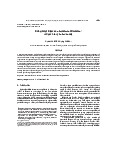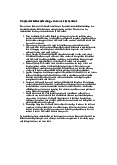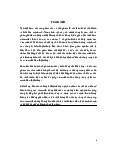






Preview text:
Behavioral bias Cognitive Errors
5 False Beliefs (Belief Perseverance) Conservatism bias:
Expression: the investor reasonably forms an initial opinion but then does not change
that opinion when new information becomes available.
Consequences: - Unwillingness or delay in updating the view and thus holding on to the investment for too long. -
Holding on to an investment for too long avoids the mental effort or stress of updating views.
• Fix: Investors need to be aware of their own biases. The more difficult the thought
process or information, the more likely it is that conservative bias will occur. Confirmation bias :
Expression: finding new information or distorting new information to support an existing view.
• Consequences: Consider positive but ignore negative information and thus hold investments for too long. -
Set up a decision process or track imprecise data to find what they want to see. -
Do not diversify your portfolio -
Too focused on the stocks of the company they work for, believing they have an informational advantage
• Remediation : seek out opposing views and information Representativeness:
Manifestation : based on the belief that the past repeats itself and that new information is
classified based on past experiences or classifications. Ignore the basic frame of
reference. The initial classification is based on a data sample that is too small and is likely unrealistic Consequence: -
Attaching too much importance to new pieces of information and over-trading. -
Making decisions based on simple rules and classifications without further
analysis, giving too much or too little weight to new information.
Fix: better understanding of the laws of probability and statistical analysis, assessing the
probability that a given investment is correctly classified within a reference group
Illusion of control bias:
Manifestation : market participants thinking they can control or influence the outcome,
often associated with emotional biases: illusion of knowledge (the belief that you know
what you don't know) , self-perception (the belief that you caused something to happen)
and overconfidence bias (an unjustified belief that you are right) • Consequence: -
Trade more than is appropriate because they mistakenly believe they can control
the outcome of the trade or are overconfident in their analysis. - No diversification
Fix: perceive investment outcomes as probabilistic, look for opposing views, Keep
records to check ideas and probabilities against reality in the past Hindsight bias:
Manifestations: selective memory of past events, actions, or past knowledge ,
tendency to remember correct views and forget mistakes Consequence: -
Overestimating the frequency of accurate predictions of events, reinforcing the
emotional tendency to overconfidence. -
Being overly critical of other people's investment performance.
Fix: ask questions like " Do I really remember what I predicted and proposed ?" -
Maintain and review complete records to identify past failures as well as
successes, reviewing success against appropriate standards
4 Information-Processing Biases
Anchoring and adjustment bias:
Expression: uses rules of trial and error based on experience to influence probability,
when individuals are forced to estimate an unknown value, they often choose an arbitrary
initial value and then try try to adjust it up or down as they process the information
• Consequence: keep the original estimate unchanged and do not adjust it when new information becomes available.
• Fix: New information does not depend on the original estimates or starting point, and
new data should be viewed objectively without regard to any original anchor point.
Ask questions like “Should I keep this stock since I originally priced the stock at a higher
price. In other words, am I becoming dependent on the previous price? Or will I base my
investment decision on a completely new analysis if this is my first time evaluating it? ” Mental accounting bias:
Expression : money is treated differently depending on its classification
For example, consider salary differently from bonuses when determining savings and investment goals.
Consequences : Structuring a portfolio in layers to meet different priority objectives
ignores the correlation between the layers of the portfolio and the results are not optimal
from a traditional perspective. Not minimizing portfolio risk by adding assets with very
low correlation. Divide returns into the categories of discretionary income, realized gains
and losses, or unrealized gains and losses. The result is too much focus on income-
producing assets, leading to lower total returns.
Fix: consider the influence of correlation between all parts of the portfolio, analyze the
maximum total return in accordance with the investor's goals and risk constraints. Framing bias:
Manifests:• when decisions are influenced by the way the question or data is “framed”
For example, if a stock is priced at 20 GBP and compared to a cost of 15 GBP, the holder
is more likely to sell (and experience the joy of realizing a profit). But if the price of
GBP20 is compared to the previous level of GBP25, then the holder is less likely to sell (and suffer the pain of loss).
Consequence: Not properly assessing risks and ending up being too risk-averse or risk-
seeking. Choose suboptimal risk for their portfolio or assets based on presentation.
Becoming overly concerned with short-term price fluctuations and trading too frequently.
Fix: Is my decision based on taking profits or cutting losses?" compare current price with intrinsic value analysis. Availability bias:
Symptoms: overemphasis on available information. Retrieval, simply focusing on what
comes to mind first. Classification, an overemphasis on how an idea is first classified.
For example, a manager assumes a stock is a growth stock and therefore screens it for
issues such as P/E and growth rate (not considering these issues). other as leverage ratio).
• A narrow range of experience can occur when the frame of reference is too narrow. For example, a candidate
Prepare for the exam by doing all the old exam questions. The contestant then said it was true
it is not fair that other types of questions are asked in the exam. Reference system
too narrow, especially as readings change and questions and answers may be stale no longer suitable.
• Resonance occurs when individuals perceive what they care about as representative
for what others will find important. Consequence:
• Choose a manager based on advertising or recall hearing the name.
• Limiting investment options to what they are familiar with leads to: • Under-diversification.
• Inappropriate asset allocation.
Fix : The Investment Policy Statement (IPS) is carefully researched and constructed
EMOTIONAL BIAS (Emotional biases) Loss-aversion bias:
Expression: more pain from loss than pleasure from an equivalent benefit Consequence:
• To avoid the pain of loss, investment holders will tend to hold securities
Securities that decrease in value for too long can sell securities that increase in value too quickly.
• Trade too much by selling for small profits, which increases delivery costs
translation and reduced profits.
• Taking on too many risks by continuing to hold assets that have decreased in quality and lost value.
• If an initial decline in value occurs, then there is often excessive risk taking with hope hope for recovery.
• Allows reference point framing to determine whether a position is considered a profit or loss.
• Treat funds created on a transaction differently from other funds and accept risk exceed that amount.
• Loss aversion occurs when a stock's short-term risk exposure incorrectly results in a premium
hedging excessively high equity risks in the market. The risk premium is too high to ignore
that long-term equity returns are favorable and result in low valuations and
undervalue the equity in the portfolio.
Fix: maintain a thorough and disciplined process based on future prospects
the future of an investment, not the perceived gain or loss Overconfidence bias:
Symptoms : market participants overestimate their intuitive or reasoning abilities -
take credit when things go right but blame others or circumstances for failure (self- righteousness). protect). Consequence:
• Underestimating risk and overestimating return. • Suboptimal diversification
• High turnover and transaction costs.
• Fix: set long-term financial goals with a budget to ensure adequate savings and
investments to achieve all goals. Self-control bias:
• Symptoms: lack of discipline and preference for immediate gratification over long-term goals • Consequence:
• Accumulated savings are not enough to fund retirement needs.
• Taking on excessive risk in the investment portfolio to try to compensate for insufficient savings accumulation.
• Focusing too much on income generating assets to meet short-term distribution needs.
• Fix: establish a proper investment plan and a budget to achieve sufficient savings
Current status (Status quo bias):
Expression: comfort with existing circumstances leads to unavailability ready to make changes Consequence:
• Holding portfolios with inappropriate risk.
• Not considering other, better investment options.
• Remediation: education on the appropriate risk/return mix and the danger of over-
concentration in the stock (of the company being worked on) Endowment bias:
Expression : an asset is considered special and more valuable simply because it is owned Consequence:
inappropriate asset allocation .
• Keep things you are familiar with because they bring comfort invisible. Fix:
• "Would you make the same investment with new money today?“
• Initiate a disciplined diversification program Regret-aversion bias:
Expression: not doing anything because you are too afraid that the action may be wrong Consequence :
riskier assets so you don't feel regret when they fall in price.
• Long-term ineffective performance and failure to achieve goals pepper.
• Herd behavior: following consensus or popular opinion. Tell yourself that it's not their
fault if other people are wrong too.
Remediation: education on the benefits of diversification, the results consistent with
effective marginal risk/return trade-offs, and the consequences of failing to achieve
important long-term investment goals.
![[QTDA] Bai tap mẫu Dong tien du an - Tài liệu tham khảo | Đại học Hoa Sen](https://docx.com.vn/storage/uploads/images/documents/banner/0cd81dfd6c7f5a5be5b3883331bd9dac.jpg)



